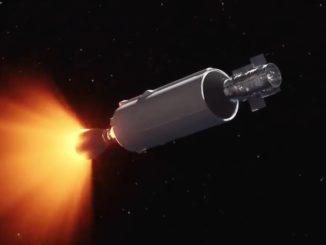
The blastoff of four broadband Internet satellites aboard a Soyuz rocket from French Guiana has been pushed back to Friday, the launch company Arianespace announced Monday.
The Russian-made launcher, modified for missions from the Guiana Space Center in South America, was supposed to take off Tuesday with four upgraded communications satellites for the O3b network providing Internet services from an orbit nearly 5,000 miles (8,000 kilometers) over the equator.
Arianespace, which is responsible for Soyuz launches in French Guiana, said Monday that the mission would be delayed to Friday to complete additional checks as part of the resumption of the company’s launches following the off-target flight of a European Ariane 5 rocket Jan. 25.
The Ariane 5 and Soyuz boosters do not share any significant hardware, but both rockets share key ground infrastructure at the European-run spaceport in French Guiana, along with oversight from Arianespace technical teams.
Arianespace did not disclose details of the additional checks to be conducted ahead of the Soyuz launch, now scheduled for Friday at 1637:06 GMT (11:37:06 a.m. EST; 1:37:06 p.m. French Guiana time).
It will be the 18th flight of the venerable Soyuz rocket from French Guiana since 2011, and the 1,885th launch of a Soyuz family booster over the past 60 years.
The Russian launch team in French Guiana rolled the Soyuz-2.1b rocket from an assembly building, known by the Russian acronym MIK, to the Soyuz launch pad Friday morning. The booster was towed along rail tracks for the 2,300-foot (700-meter) trip to the launch pad, then erected vertical on mounts before a mobile gantry moved into place around the rocket.
Ground teams will transfer the Soyuz rocket’s Fregat upper stage and the four O3b satellites, already affixed to a dispenser inside the launcher’s payload shroud, to the launch pad Tuesday. Cranes will hoist the Fregat stage and the four satellites atop the Soyuz rocket for attachment and final compatibility tests.

A launch rehearsal is on tap Wednesday, followed by a launch readiness review Thursday to assess the status of the rocket, the satellites and ground systems ahead of Friday morning’s countdown.
Built by Thales Alenia Space, the four O3b satellites will join 12 others launched from French Guiana aboard three Soyuz rocket flights in 2013 and 2014.
Each spacecraft weighs around 1,543 pounds (700 kilograms), and the Soyuz rocket’s Fregat upper stage will fire its main engine three times before deploying the first two O3b satellites into orbit 4,865 miles (7,830 kilometers) over the equator around two hours after liftoff.
A brief fourth firing of the Fregat engine will set up for separation of the other two O3b satellites in a similar orbit.
The O3b satellite fleet, owned by SES Networks, provides broadband connectivity to Internet service providers, network operators, governments and maritime customers, including cruise ships. O3b is short for the “other 3 billion,” a nod to the nearly half of the world’s population without access to reliable broadband Internet services.
Eight upgraded O3b satellites ordered from Thales Alenia Space in December 2015 will answer growing demand for the “fiber-like” connectivity offered by the space network, which is positioned in a “medium Earth orbit” more than four times closer to the planet than conventional telecom satellites in geostationary orbit.
The lower altitude reduces the latency, or lag time, experienced by customers sending and receiving data through the network.
Another set of four O3b satellites will launch on a Soyuz rocket from French Guiana in 2019 under a contract signed between SES and Arianespace last year.
Email the author.
Follow Stephen Clark on Twitter: @StephenClark1.



